FiraTàrrega International Festival is a project that deserves our attention for a number of reasons. It is not only a fascinating artistic event, featuring a rich and diverse programme that attracts hundreds of professionals from around the world, but is also a kind of social phenomenon. During the festival, the small, unremarkable town of Tàrrega (ca 16.5 thousand inhabitants) is transformed beyond recognition – it pulsates with the rhythm of excellent theatrical, musical, and dance performances and fills with visitors. These include not only theatre professionals from Spain and other countries, but also residents of nearby towns and more distant cities, who come to Tàrrega to experience this vibrant artistic fiesta.
FiraTàrrega Festival (Fira de Teatre al Carrer) was established in 1981 on the initiative of the then president of Tàrrega, Eugeni Nadal. He aimed to transform a local festival into a large event, encourage local residents to get involved and put the whole town to the service of a concrete project, in this case, the theatre. The medieval layout of the town allowed the organizers to concentrate the venues in the centre, which centralized the shows and brought the audience together, turning them into protagonists of the event. Gradually, Fira evolved. Various aspects of the festival developed – paid-entry performances were added to the programme and an organizational structure emerged. The international character of the event grew, and the role of presenters and curators from around the world of the fair became more pronounced. A study commissioned in 2000 by the University of Lleida at the request of the organizers indicated that Fira generates for the town and the surrounding area revenues of €3 million every year. The study was repeated in 2004 and resulted in similar findings, confirming the huge impact of the festival on the economy of the region (data from “FiraTàrrega. History dossier (1981 – The present).”
Festival events transform Tàrrega into a theatrical stage – every part of the town centre becomes a stage. The celebration of theatre engages its residents, offering them the chance to see great performances, as well as involving them in the work of organizing the festival. Local bars and restaurants flourish, and residents rent out their spare rooms to supplement the town’s modest hotel resources.
Every year, the FiraTàrrega Festival, which lasts just four days, gathers about one hundred thousand spectators (indoor and outdoor performances). Every year, several hundred theatre industry experts from all over the world receive professional festival accreditation (this year the number of professional accreditations covering Spain and other countries exceeded one thousand). Large number of journalists are also present at the festival – including reporters from: tve, Catalunya Ràdio iCatFM, La Xarxa, Lleida TV, Ràdio Tàrrega, Tàrrega TV, Segre and specialist media, including Artez, Entreacte, Fiestacultura, Núvol, Recomana.cat, Teatralnet, Territoris.cat, Zirkólika.
FiraTàrrega combines several important aspects: a rich and diverse demonstration of the new Spanish – predominantly independent – theatre with presentations of performances and international projects and a kind of art fair, although I must say that I am reluctant to use this word. Not because I have doubts about the importance and significance of the festival; especially when it comes to establishing extremely valuable professional contacts. This takes place in such a friendly and relaxed atmosphere. Thanks to the incredible efficiency of the highly professional organizers, these meetings simply take the form of honest conversations, an exchange of information, introduction of different projects. Here, we talk about our work and hear all about the work of others. This very often results in collaborations and performances at various other festivals.
FiraTàrrega is a significant meeting space for performing arts professionals from all over the world. The main meeting point is the La Llotja pavilion (otherwise used as a sports hall). It houses all kinds of advertising and information stands of organizations promoting theatre initiatives from different countries, artistic agencies, groups, presenters, and festivals. You can leave leaflets and information here. This is also where (as well as several nearby locations) a rich and varied program of presentations, debates, and meetings takes place. Some of these are dedicated to the performing arts from a specific country or region, others are devoted to a particular theme or issue.
Among the countries that regularly host their information points and organize presentations are, among others, Portugal, Ireland, Great Britain, as well as different regions of Spain – Catalonia, Balearic Islands, Basque Country, Navarre, and Valencia. Some countries take part in the event as part of particular projects or collaborations taking part over a given period of time. Until 2014 projects highlighting particular countries were implemented under the slogan “Focus” and focused on, among others, Quebec, Ireland, Latin American and Scandinavian countries. Such project devoted to four Central European Visegrád Group countries (Czech Republic, Slovakia, Hungary, and Poland) was carried out in Tàrrega in 2014. That was the final year of the “Focus” series, although the very idea of highlighting a given region or country is now returning, again. The project anticipated the presentation of one performance from each country and the participation of invited curators and delegations from these countries (which were to be covered by a grant) and other activities facilitating an exchange of experiences. The Czech Institute of Arts and Theatre prepared an application for funding from the International Visegrad Fund. Theatre institutes from Slovakia, Hungary, and the Polish Zbigniew Raszewski Theatre Institute worked together on the project. Unfortunately, it was not possible to obtain funds from the Visegrad Fund at that time (so, the actions taken in the end were not communicated as Visegrad Fund-funded activities). So, it was also necessary to limit the scope of the planned project. In the end, Slovakia’s Jaro Vinarski’s performance did not take place. Instead, Sergeant Tejnorová & the Commando and VerTeDance & Jiří Havelka & Clarinet Factory (representing the Czech Republic), Stereo Akt with a performance directed by Martin Boross from Hungary (with the participation of Polish actress and performer Julia Jakubowska), and the KTO group from Poland performed at the festival. The programme also featured a seminar on the conditions in the performing arts in Central Europe: Czech Republic, Slovakia, Poland, and Hungary (“The current performing art scene of Central Europe: Czech Republic, Poland, Hungary, and Slovakia”). Thanks to this, the international audience present at the festival could obtain information on the way theatres are organized and work in these countries, about festivals that take place there, and the latest developments in theatrical life in this region of Europe. The shared information point offered promotional materials related to theatre in Poland, Czech Republic, Slovakia, Hungary, and the dramaturgy of these countries. The programme also included another Polish accent – a performance co-produced by the Catalan group Les Filles Föllen and Barbara Wysoczańska from Poland.
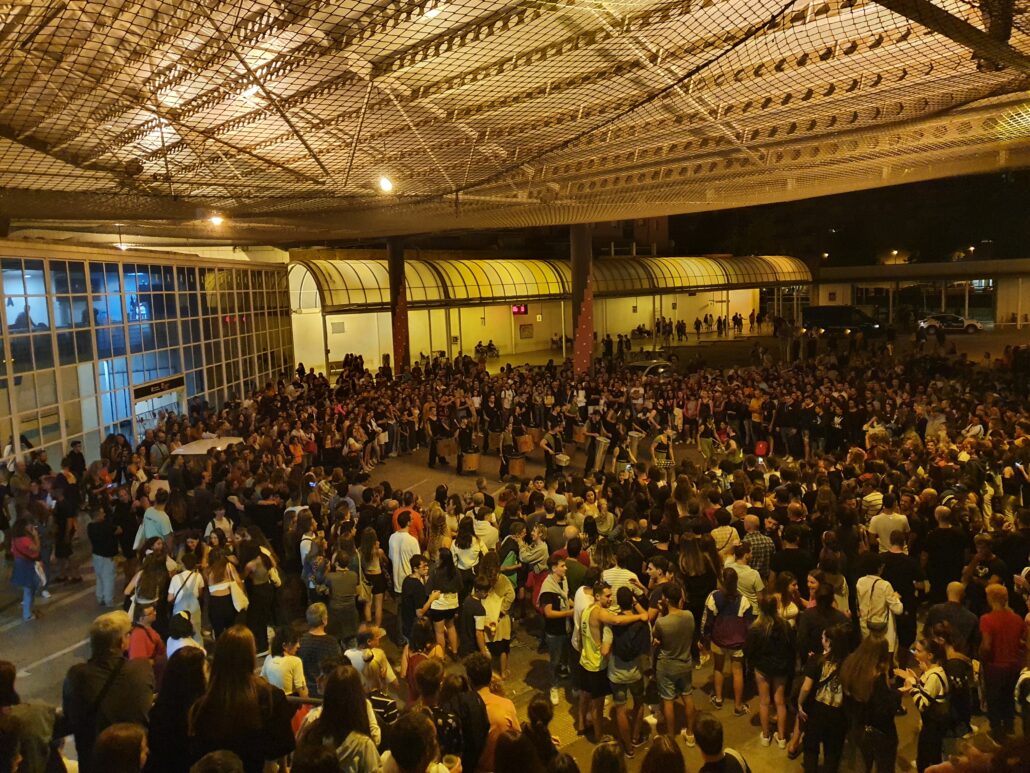
Apart from the 2014 edition of the festival, companies from these four countries appeared in Tàrrega as part of the main programme only three times – Teatr Strefa Ciszy (2010), Muzikanty (2016), and KTO, again, in 2018. The Prague Institute of Art and Theatre also returned to promote Czech performing arts. Curators from these countries also travelled to Tàrrega in order to represent their institutions and projects. This includes the writer of these words – as I mentioned earlier, the innovative and unique programme of FiraTàrrega offers a unique opportunity to establish new contacts and be on the lookout for original projects and performances.
Meetings and discussions provide a great opportunity to tell the curators and artists, as well as representatives of institutions supporting the arts present at the festival, about the work and achievements of the Silesian Theatre and the International OPEN THE DOOR Festival (organized by the Silesian Theatre since 2018), of which I am the programme curator. The programme of the OTD Festival is open to a variety of theatrical and artistic activities, including drama performances, artistic and outdoor theatre, dance theatre, movement theatre, projects, and performances carried out in the public space, concerts, and other interdisciplinary activities. There is also an important social dimension – the festival engages with questions of exclusion and actions aimed at inclusivity and increasing accessibility. And FiraTàrrega is a great place to look out for valuable, bold projects.
The organizers not only carefully select projects that have already been carried out or are already available, but also support the development of performing arts, especially projects taking place in the public space and avant-garde activities. Across the various periods of the festival’s history, these goals were served by various activities and projects. In 2007, the term “creative land” accompanying the name of the FiraTàrrega festival first appeared, and in 2011, the “Support to Creation” project was initiated. Another interesting and significant initiative was the establishing, together with the University of Lleida, of the MA Degree in Street Arts Creation.
Fira is keen to engage, initiate and conduct large-scale international projects, for example, Meridians with the participation of seven other European festivals, an exchange with the London Greenwich+Docklands Fresh Street #1 festival – the first European seminar on the development of art in public space, as well as Circus and Street Arts Circuit – CASA – the European cooperation programme between professionals dealing with street art, contemporary circus and many others.
These kinds of projects are another element of the organizers’ strategy – a way to support the processes of creation, initiating and creating opportunities for the dissemination of performances, and mobility of artists and their work. Today, Tàrrega is one of the most important international festivals taking place in Europe and the undisputed leader among these kinds of projects in Spain.
One of the new tools supporting professional exchanges is the FiraTàrregaPro platform – here, anyone can present their project, make an appointment, browse the database of professionals, organizers, and artists.
FiraTàrrega is also a festival that helps us realize what kinds of events could be addressed to the so-called wider audiences/the general and local public. It turns out such events could in fact be interesting, innovative, and original. This may seem shocking – at least from the Polish perspective – considering that for some unknown reason, whenever there’s talk of an event addressed to the so-called public, it is expected to engage commercial performers, and assume that the public is absolutely devoid of artistic interests. Tàrrega proves that having faith in the public and the local community not only does work, but also strengthens the ways in which local residents can identify with their town; it hugely improves the town’s public image and in turn translates into measurable economic benefits. Introducing a presentation on the work of Catalan artists, the current mayor of Alba, Pijuan Vallverdú, said that Tàrrega has grown alongside Fira. This statement, the awareness of the potential that an artistic project of such quality can have for a town, is heart-warming. The quality and international dimension of the festival do not instigate a lack of interest of the local audience – on the contrary, the important, often experimental performances – as I have repeatedly emphasized here, invariably attract crowds of spectators.
The programme of the FiraTàrrega festival is truly diverse. It is impossible to describe all events here, but it is worth highlighting at least a few projects to give you an idea of its diversity and scale.
The beating heart of the festival is public space – there, we will not find only large-scale shows, although such performances make up some of the festival’s programme. The town’s plazas and squares also host dance projects – sometimes small, sometimes large-scale and spectacular – consistently attracting hundreds, and sometimes thousands of spectators.
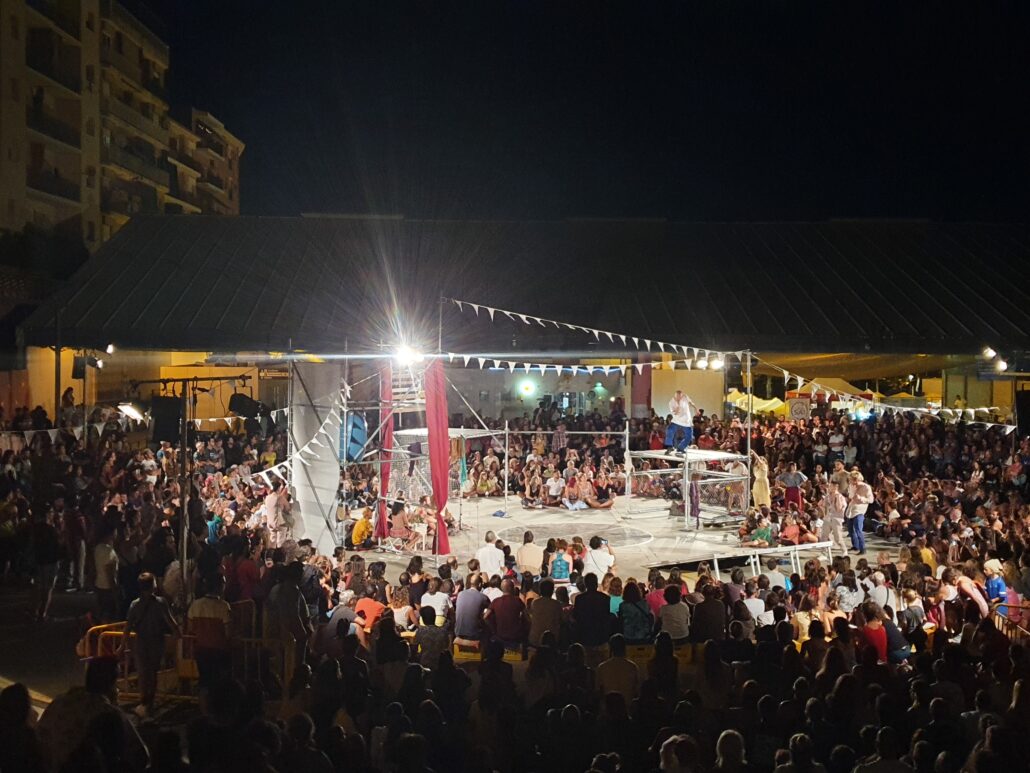
This year [2022], crowds of spectators attended the wonderful dance performance “Mirage (un jour de fête)” by Compagnie Dyptik. Inspired by scenes from the everyday life of a refugee camp, the performance captivated the audience with its dynamic, or even daring, choreography. The creators of the performance evoked scenes of conflicts, animosities, tensions, but also revealed that even in such difficult circumstances, life can go on, and people still strive to attain moments of happiness – be it by celebrating birthdays, or performing everyday chores that almost turn into rituals allowing them to tame the transient nature of existence. At some point during the performance, there was a recurring sequence of dynamic dance, the dancers circled around the stage at an incredible pace – on the one hand, their infectious vitality conveyed hope, and on the other, the almost destructive pace of their dance induced anxiety, an energy born of despair.
“Orpheus” by the Insectotròpics was an example of an outdoor performance that used video art and a kind of animation in an interesting way. The myth of Orpheus and Eurydice was confronted with the current moment – technologies promising a chance to prolong life, survival, and contact in virtual reality. The desire to protect the loved one thus takes on a brand new, somewhat disturbing dimension: revealing the desperation and helplessness that betray us to the preachers of various dangerous theories.
More modest dance projects presented in the public space are also of great interest to the audience in Tàrrega. These are often performed in one of the main squares of the town – Plaça de les Nacions. The audience arrives earlier, to ensure the best possible view, and patiently wait for the performance. This year saw the performance, apart from the aforementioned “Mirage”, of “Born to Protest” (choreography by Joseph Toong) – a strong voice in debates concerning racism, discrimination, and racial stereotypes. Dance projects of different scales appear in various parts of Tàrrega – sometimes in fenced off, smaller squares or courtyards, such as the original dance project, “Los Perros” (Led Silhouette + Marcos Morau), in which the dancer’s moves and interactions open us up to various associations and free our imagination, allowing us to interpret images and situations in our own, personal way. Sometimes these projects appear as unexpected études or activities resembling “interventions” in the public space, toying with the passers-by, such as the project “Troc!” based on a gesture proposed to a dancer by a chance spectator. (Sauf le dimanche).
The Tàrrega Festival also allows us to learn what the term “contemporary circus” can mean – often including aesthetically sophisticated projects and performances, executed with acrobatic proficiency strongly intertwined with choreography. A great example of this is the performance “Picaderø” (Haa Collective), which combines contemporary circus art, installation art, and music. In it, the spinning circular plane becomes an impulse to experiment with the balance and movement of dancers-acrobats.
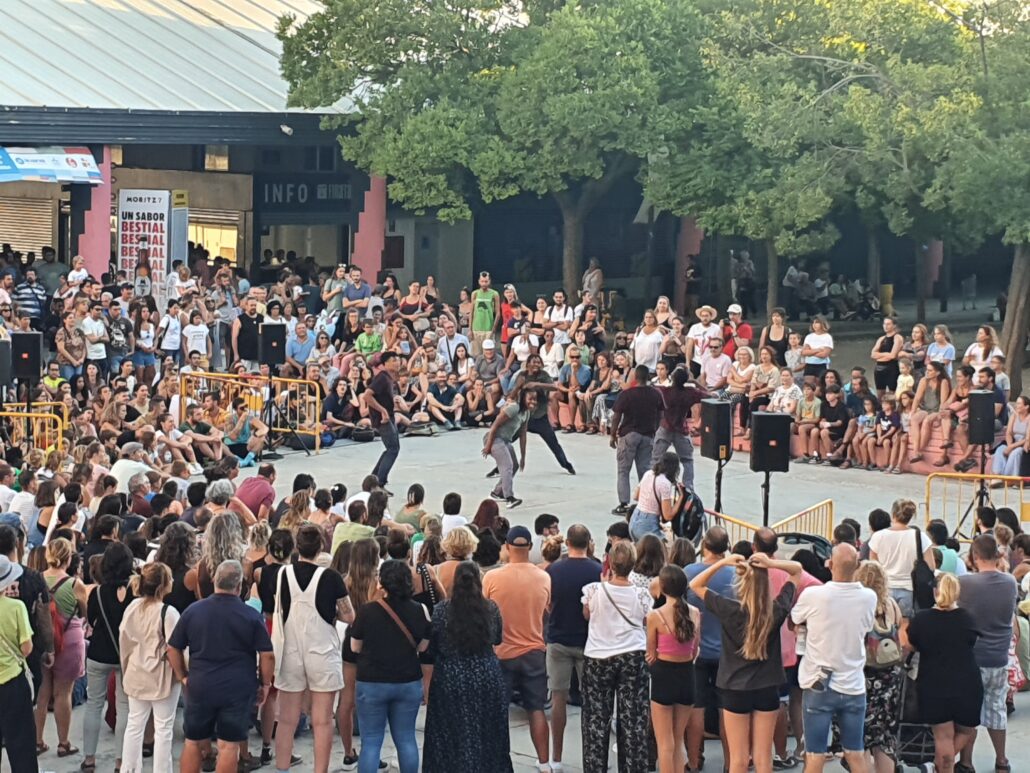
A beautiful example of such performance is also “Maña” by the group Cia. Manolo Alcantara – an almost meditative performance, in which we witness the creation of a certain complicated construction. Everything here constitutes a harmonious whole – the form, the colour of elements used to build it, the fabric from which the performers’ costumes are made, the methodical, rhythmic movement of the “builders” giving the impression of lightness and freedom despite the extraordinary complexity of the activities performed. Another example of acrobatic precision, combined with interesting movement, is the performance “Exit” by the group Circumstances. The “door theme” provides the starting point for the construction of countless situations and acrobatic and choreographic arrangements. The performance of “Zloty”, created by Pau Palaus, is an example of how poetic a circus performance can appear. It is basically a meta-narrative whose protagonists are two former circus artists, a story about living on the road, based on the ability to build interactions and a relationship with the viewer, reminding us that theatre is the art of experiencing and feeling together. Of course, there is no shortage of proposals for children in the festival’s programme, and the programme also features plenty of captivating music.
The festival programme also includes performances based on contemporary drama addressing important social issues, texts by young artists reacting to the world around them – often rebellious and uncompromising, experimenting with the word and its relationship with theatrical forms – such as for example “Lacrimosa” (Fundación Agrupación Colectiva), addressing the subject of young people devoid of any perspectives, living with a feeling of disappointment, defeat, and lack of meaning. “Exit Through the Gift Shop” (by Carla Rovir) was also rather poignant – a thought-provoking performance focusing on the experience of expecting a child, hope, dilemmas, and despair resulting from a disastrous diagnosis suggesting the risk of serious diseases, the loneliness in the face of such a threat, the body that becomes the object of countless, often incomprehensible, medical procedures. This performance was also accompanied by an art installation.
Another unique and important project presented during this year’s edition of the festival was “Rune” by Amer Kabbani (Cia. 104º). The Syria-born artist used his acrobatic workshop to tell a story that evoked images of war, the fate of anonymous victims, people who perished beneath collapsing buildings. Stones featured in the performance were used to examine the sense of balance, but also to burden and overwhelm the performer, serve as a painful reminder of ruins and the search for people trapped in the ruins, the attempts to reconstruct their history.
Projects that provide a fearless response to the world around us were another significant aspect of the programme. This year, environmental themes have featured several times – for example in the performance “El dia que va moror L’ultima Panda” (Projecte Ingenu) – presenting a vision of a future, in which pandas are an extinct species brought back to life thanks to the efforts of scientists. The show posed important questions about the relationship between nature and new technologies, and the ways in which we use and exploit natural resources.
The issue of our treatment of the natural and social environment, history, and tradition was also taken up by the project “S.O.S” by the wonderful performer Ada Vilaró. Her performance-manifesto combined a poetic confession with a call to action. The show took place in an open space, surrounded by fields and a nearby forest. We watched it while sitting on pieces of wood or hay. In silence, we looked at the performer lying motionless on a block of ice, gradually melting under the warmth of her body. This almost meditative scene, quickly turned into a dance sequence featuring a chainsaw – an image of strength and destruction followed, again, by silence. The performer uttered a kind of confession and manifesto single-mindedly showing us the need to change our way of thinking and redefine how we use resources – both natural and material – the status resulting from our social position, race, or privilege. Vilaró ended the performance by reciting lines together with a group of women, members of the local community, people of different ages, who one by one got up and left the audience to join the artist, and finally leave with her and disappear into the nearby forest.
This clearly shows that Fira builds a genuine relationship with its audiences – a relationship based on dialogue, respect, and joint exploration of important issues. No one has ever said that only mass, ludic, carnivalesque entertainment can be interesting or satisfying. And yet, there are only a few festivals that, like FiraTàrrega, are able to involve the public in important discussions.
As you can see, experimental projects are an important part of the festival. Events in the public space do not have to take the form of a performance or a spectacle. For example, we can meet early in the morning to wander the streets of the city with the artists from the group 1 Watt (“Tales of Noone”), who in their project combine elements of an autobiographical narrative with reflections on art present created in public space – its form and function, and our expectations towards them. An exploration of art is intertwined with an exploration of life; theirs is a narrative about constantly asking ourselves questions about freedom, honesty towards oneself, and our own desires. It’s a story of vigilance towards one’s own potential opportunism. A story that we complete together with the artists – allowing ourselves to be swept away by the rhythm of the music closing this parade, which may even awaken in us the dormant spirit of a proper rebellion.
Some experiments in Tàrrega were bold and radical. Taking part in the performance “Hablar con las plantas para llegar a un paisaje” by the group Artistas Salchichas, we took a bus outside the city, and then, equipped with headphones, following their narrative, we set off on a bicycle journey through the nearby fields. Participating in the “Reverse” project by Johannes Bellinx, we wandered the streets of Tàrrega. We followed the lines drawn on pavements and streets… walking backwards, giving in to a feeling of uncertainty, allowing the hand of an invisible person standing behind us to lead us across the street, to guide us. We learned to see and decipher the signs left for us, and by allowing ourselves to give in to this reversal of roles, we opened ourselves up to a new experience and saw the town in a new light.
Undoubtedly, another example of a radical experiment was the project “Dormifestaió” (Roger Bernat/ FFF) – an exploratio and experience of a shared dream. To take part, we arrived late in the evening in a nearby park. There, camp-beds arranged in rows were waiting for us. Each person took a bed, and those with trouble falling asleep could go up to a tent standing on the side and receive sheets of paper to write down their thoughts and reflections, there was also warm tea available. People sat on the beds, someone read a book to help others fall asleep, while someone else savoured the silence and the glistening sky above their head, suddenly transported into the sphere of silence, far away from the hustle and bustle of festival life.
The projects described here are just a few examples of particular trends or threads intertwined in the programme of the FiraTàrrego festival. This diversity is complemented by the rich “Zona Off” programme featuring performances of alternative artists – clowns, musicians, acrobats, larger and smaller bands – in various parts of the town. Each of those venues has its own busy schedule. Performances take place late into the night, often ending at 1 or 2am. Of course, they are also attended by locals enjoying this theatrical experience and celebration.
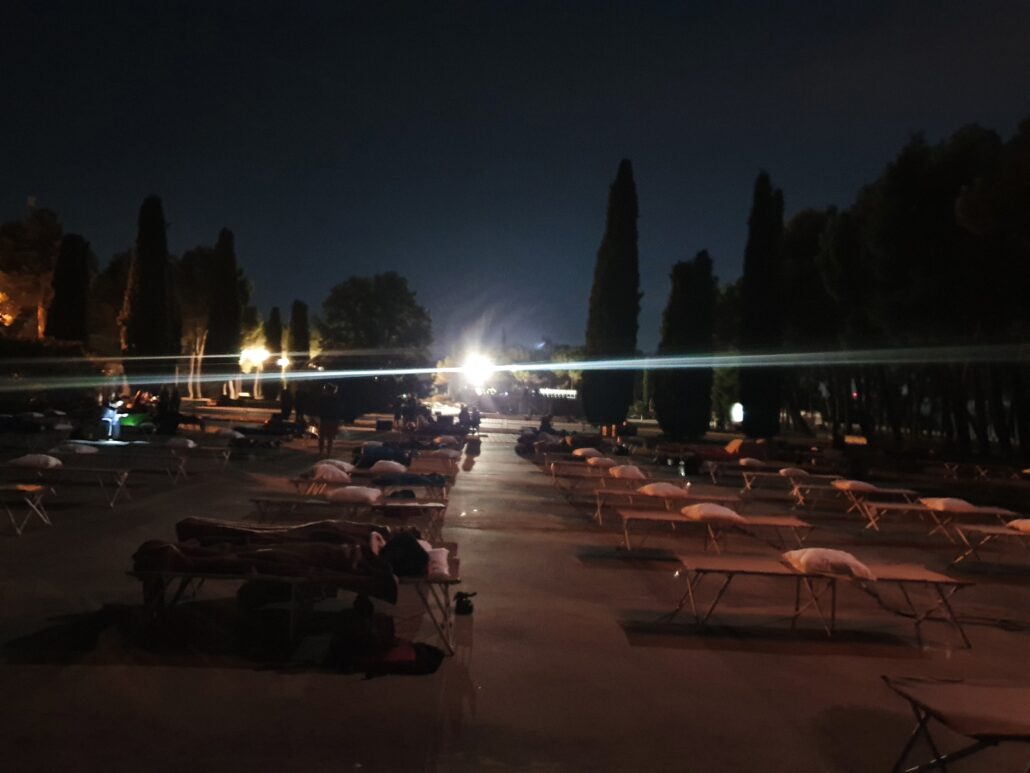
Whenever I visit Tàrrega, I think that we underestimate the imagination and openness of theatre audiences. FiraTàrrega clearly demonstrates that the local community can be a partner in artistic dialogue. By allowing people a chance to experience interesting, diverse theatre, we create opportunities for dialogue, we launch different kinds of conversations. We build relationships. And building relationships involves trust and risk, it requires having faith in one’s interlocutors.
FiraTàrrega is an excellent example of how we can support artists and the growth of the performing arts. It is somewhere where we can stimulate our imagination, and come across valuable artistic projects and potential partners for future collaborations.
text: Dagmara Gumkowska
translation: Joanna Figiel
cover photo: „Poi” – Cia. D’es Tro, FiraTarrega Theatre Festival 2022; photo: Dagmara Gumkowska

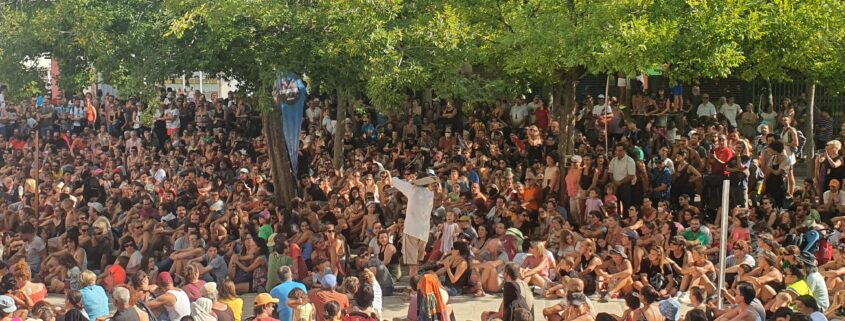


Leave a Reply
Want to join the discussion?Feel free to contribute!